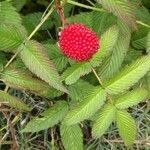Shrubs, 5–10(–15) dm, armed. Stems ?annual?, arching to mounding, glabrous, eglandular, not pruinose; prickles sparse, slightly hooked, stout, 3–4 mm, broad-based. Leaves deciduous, pinnately compound; stipules lanceolate to oblanceolate, 8–13 mm; leaflets (3–)5–7, terminal lanceolate to narrowly ovate, (5.5–)6.2–8.5(–9.7) × (1.8–)2.2–3(–4.2) cm, base usually rounded, sometimes truncate to subcordate, unlobed, margins finely to coarsely doubly serrate, apex acuminate, abaxial surfaces with prickles on midvein, glabrous, eglandular. Inflorescences solitary flowers or 2–3-flowered clusters. Pedicels: prickles sparse, slightly hooked, glabrous, eglandular. Flowers bisexual; petals white, broadly obovate to suborbiculate, 12–15(–18) mm; filaments laminar; ovaries glabrous, ?styles glabrous?. Fruits red, oblong, 1.4–2 cm; drupelets 50–100, strongly coherent, separating from torus. 2n = 14.
More
Stems sparsely beset with wide-based prickles, otherwise glabrous and glandless; lvs pinnately compound; lfls 5–9, lanceolate, 7–10 cm, sessile, serrate; cor white, 3–4 cm wide; pet spreading, broadly obovate; fr red, to 3 cm, separating as a unit from the persistent receptacle; 2n=14. Native of Japan, escaped from cult. here and there in our range.
A low bramble. The fruit are red.
Can be grown by seedlings. Seeds needs stratification.

